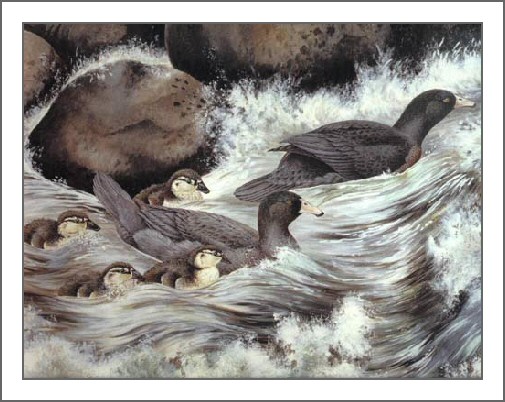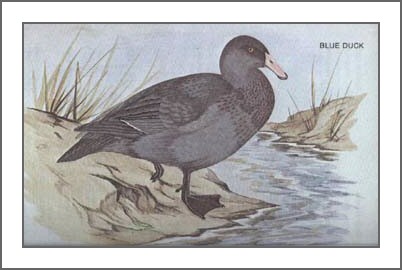

SCROLL DOWN TO FIND MORE FRESHWATER BIRDS:
SHOVELER; BLUE DUCK; BROWN TEAL; MARSH CRAKE & SPOTLESS CRAKE;
BANDED RAIL; PUKEKO; AUSTRALIAN COOT.
![]()
SHOVELER DUCK / Kuruwhengi
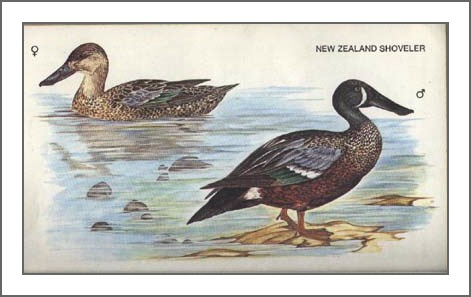
NZ Shoveler Duck Anus rhynchotis FAMILY: Anatidae
Endemic to NZ with a closely related race in Australia. Protected, but may be hunted in the open season.
This duck is smaller than the Mallard, and has a prominent wide bill which it holds pointed downwards when
swimming. Found throughout NZ on lakes and lagoons near the coast. They feed by dabbling. Breeding is from October
to January. The nest is usually of grasses and lined with down, near water and among long grass in open areas.
The eggs, 10-13, are a pale creamy-white. The female only incubates with the
male assisting in the rearing of the chicks.
![]()
BLUE DUCK / Whio
|
|
|
Blue Duck Hymenolaimus malacoryhynchos FAMILY: Anatidae
Endemic and fully protected. Smaller than the Mallard Duck with a prominent narrow bill which is pinky-white with
a black edge to the tip. Blue Duck are dove-grey in colour, heavily spotted with chestnut on the breast.
The male has a whistling call while the female a gutteral rattle. They are seen singly or in family groups.
Found in the North and South Islands, but they are now restricted to mountain and bush streams in undeveloped areas.
They feed on insect larvae by diving. Breeding is from August to November and the nest is on the ground under thick
vegetation or in holes close to a stream. The nest is lined with down, and the eggs, 4-9, are creamy-white.
![]()
BROWN TEAL
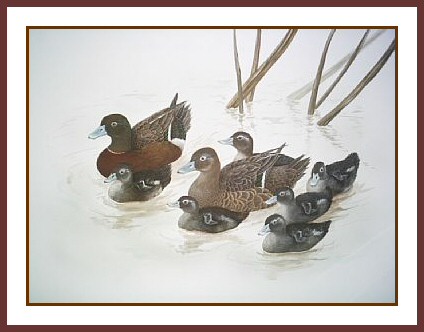
Brown Teal Anus aucklandica FAMILY: Anatidae
Endemic, with a related flightless sub-species in the Auckland Islands. Fully protected. This is a small, chubby duck,
generally warm brown in colour. The male is darker than the female, who lacks the white neck ring
and flank patch which the male has. It has a strong flight but flies infrequently. Brown Teal were one of the most
common of the ducks last century but is now rare. It is now being reintroduced in suitable areas from hand reared stock.
It is now found on Great Barrier Island, North Auckland, Stewart Island and Fiordland. Brown Teal inhabit estuaries
and slow-flowing rivers in the north and sheltered coasts in the south. They feed by dabbling, on snails, plants and
water insects. Breeding is from July to October and the nest of grasses, lined with down, is well concealed near water.
The eggs, 5-7, are cream.

![]()
MARSH CRAKE & SPOTLESS CRAKE
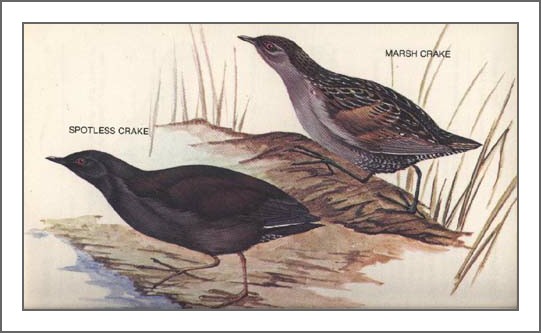
Marsh Crake / Koitareke Porzana pusilla FAMILY: Porzana pusilla
Native to NZ with five similar sub-species in Europe, Asia, Australia and Africa. This is the smallest of the
NZ rails, skulking in cover and rarely taking flight. It is widely spread throughout the main islands, but is
rarely seen. Marsh Crake inhabit fresh and salt water swamps and the reedy banks of rivers and lakes.
They feed on green vegetation and seeds, molluscs and insects. Breeding is from October to January and the nest,
a flat cup of rushes, is built close to water. The eggs, 4-8, are olive-brown, sometimes with dark flecks.
![]()
Spotless Crake / Puweto Porzana tabuensis FAMILY: Rallidae
Native with three sub-species in the SW Pacific and Australia. Fully protected. Dark all over, this bird skulks in cover
and rarely flies. It swims and dives readily. Spotless Crake are distributed throughout NZ and some outlying islands.
It is found in swamps and marshy areas like where there is Raupo growing, but in forests on islands. Their secretive nature
means that they are seldom seen but they will come to recorded calls. Food is the same as the Marsh Crake.
Breeding is from October to December. The nest is bulky, loose woven of sedge and grass, with several play nests
in the close vicinity. The eggs, 2-3, are usually pinky-cream, blotched and spotted all over with brown.
![]()
BANDED RAIL / Mohu-pereru
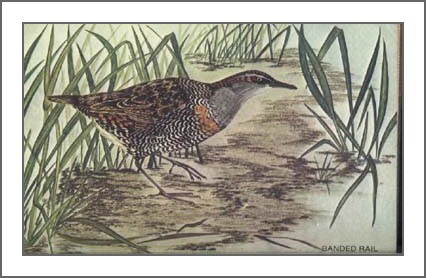
Banded Rail Rallus phillipensis FAMILY: Rallidae
Native and also found in SE Asia, Australia and the SW Pacific. Fully protected. This secretive bird runs swiftly
and is rarely seen flying. They are found throughout NZ and although common they are rarely seen.
They inhabit swamps, lake edges, salt marsh lagoons, mangroves, or drainage ditches with cover. They feed
on insects, worms, snails and seeds. Breeding is from September to February and the nest of grasses and rushes
is well hidden near or above water. The eggs, 4-7, are pale pinkish-buff with scattered reddish-brown or
purplish-grey spots and blotches.
![]()
PUKEKO
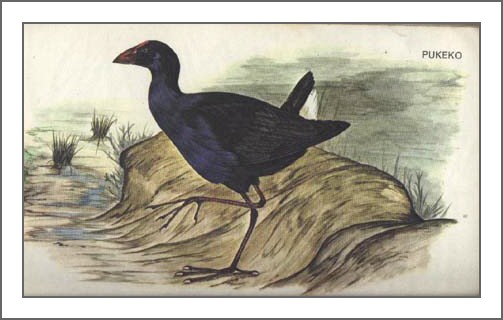
Pukeko Porphyrio porphyrio FAMILY: Rallidae
Native and also found in Australia. Pukeko are protected but may be hunted in the open season in some
areas. They are bright blue and black with white undertail coverts. They often flick their tail and run fast. They are
reluctant fliers, flying with their heavy legs dangling. They are found throughout NZ in marshes, swamps, lakes,
lagoons, and river banks with raupo and scrub for cover. They are often seen near wetlands and feed on a wide
variety of plant matter, insects, snails and sometimes eggs of other ground nesting birds. Breeding is from
August to March and the nest is a large structure in swamp vegetation. The eggs, 4-8, are usually reddish-cream with
variable red-brown spots and purple blotches all over.
![]()
AUSTRALIAN COOT
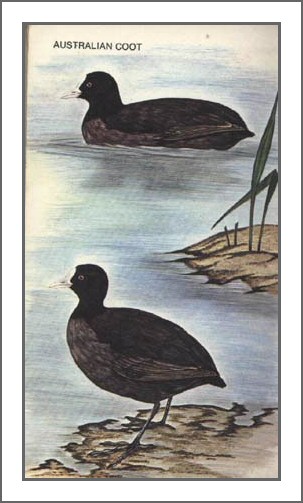
Australian Coot Fulica atra FAMILY: Rallidae
Native, staggling from Australia since 1875 with a large increase
and subsequent breeding in the 1950s. Fully protected. Lightly smaller than the Pukeko, this bird is seen mainly on water.
They are all black with a white bill and frontal shield and a jerking head when swimming. Immature birds are grey with
a dark bill. Found in scattered pockets through both islands, breeding in Otago, Canterbury, Wanganui, Wairarapa, Rotorua
and Hawke's Bay. They feed by diving, on insects, snails and water plants. Breeding is from October to December.
The nest, made of sticks and dead rushes, neatly lined with raupo leaves, is large and well hidden in swamp vegetation.
The eggs, 5-7, are brownish-cream, minutely dotted with black spots all over.
![]()












